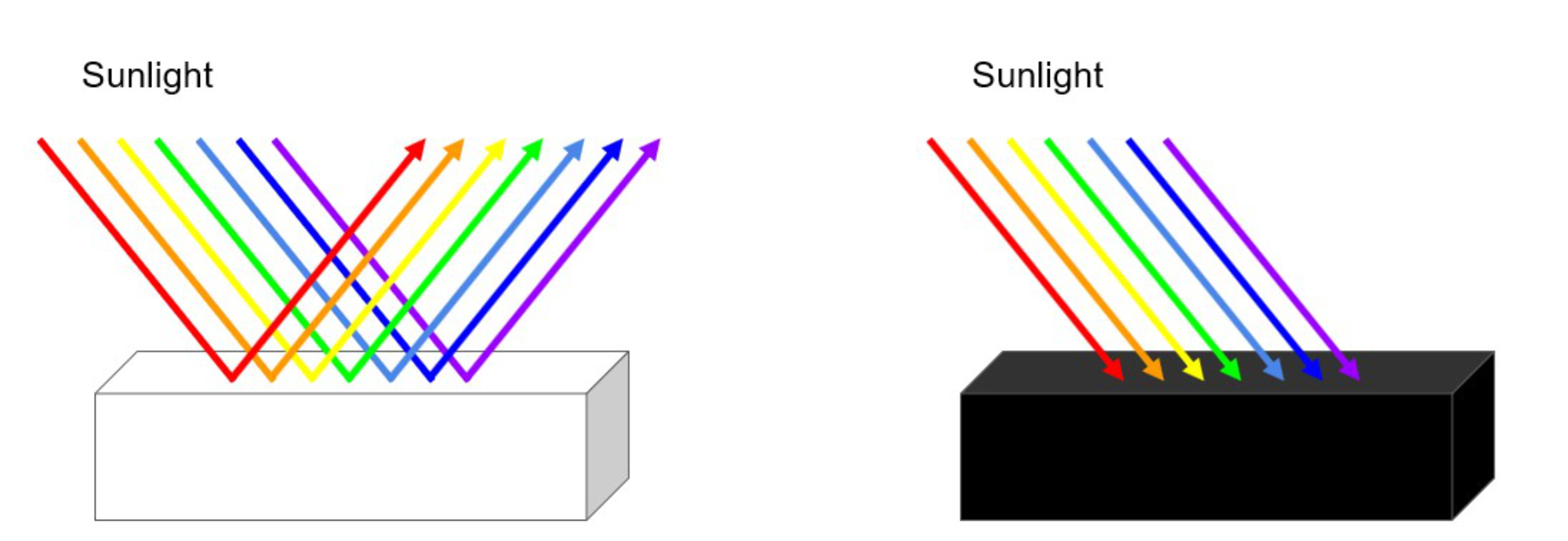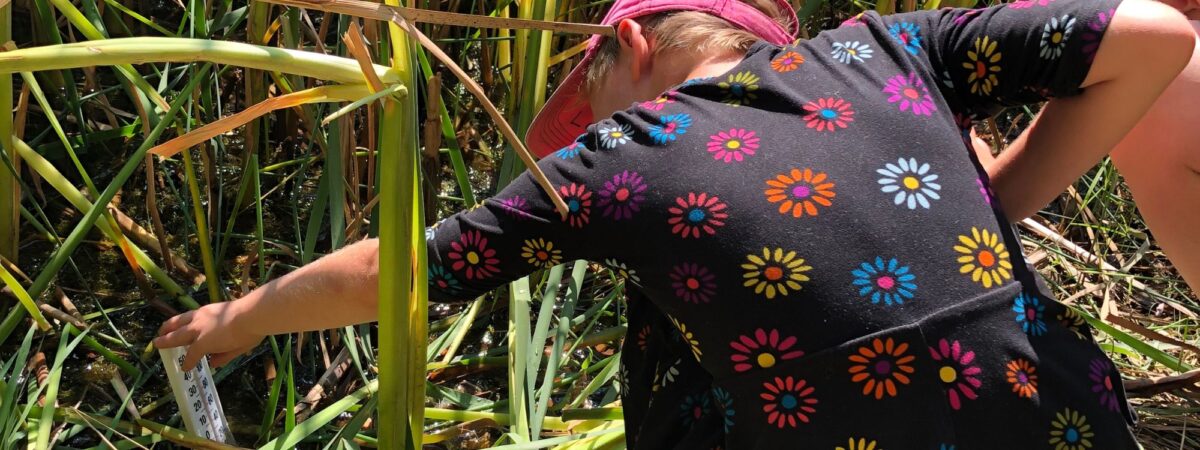Overview
We all probably have some intuition about air temperatures, for example, that on a sunny day it’s cooler in the shade than it is in the sun. But how much cooler is it? What else affects temperature? How did people stay cool on hot summer days before we had air conditioning and electric fans? Students will make some measurements and then think about how they could apply what they learned to come up with strategies for staying cool during extremely hot days.
Introduction
Students use basic thermometers to measure air temperatures under different conditions, draw conclusions about why air temperatures differ in these conditions, and apply what they've learned to strategies for staying cool during extreme heat events.
Grade Level
K-5
Learning Objectives
Students will
- learn to use scientific instruments (thermometers) and to record data
- explore temperatures in different locations and scenarios
- use scientific data to develop strategies for staying cool in extreme heat
Lesson Format
This activity is intended to be done outdoors on a sunny day.
Time Required
30 to 45 minutes
Standards
NGSS
- Make observations to determine the effect of sunlight on Earth’s surface. K-PS3-1
- Use tools and materials provided to design and build a structure that will reduce the warming effect of sunlight on an area. K-PS3-2
- Ask questions to obtain information about the purpose of weather forecasting to prepare for, and respond to, severe weather. K-ESS3-2
- Make a claim about the merit of a design solution that reduces the impacts of a weather-related hazard. 3-ESS3-1
Credits & Contact Info
Dr. Ingrid Zabel
Paleontological Research Institution, 1259 Trumansburg Rd., Ithaca NY 14850
zabel@priweb.org
Instructions & Materials
Materials
- Thermometers (simple indoor/outdoor thermometer)
- Data collection sheet
- Pencils
- Clipboards
- Half black / half white surface (flat piece of cardboard painted half black, half white)
- Optional: light-colored summer hat, dark-colored winter hat

Instructions
Before the activity, select about five locations outside for students to take temperature readings. Pick at least one location near a building (preferably a wall facing the sun), one far from a building, one in a shady area or near a tree, and one in direct sunlight. If available, measure temperature directly above an asphalt or other very dark surface directly in the sun. Set the black & white surface outside so it has at least a few minutes in the sun.
Demonstrate how to read a thermometer. Many thermometers have both Celcius and Fahrenheit scales—it doesn’t matter which the students use as long as they are consistent. Ask students to make and record measurements in all the locations, and over both halves of the black & white surface. Students should place their thermometers on a flat surface and let them sit for at least 2 minutes in order to get an accurate reading.
Download data collection sheet here.
Discussion questions
- Were your temperature measurements what you expected to find in different places?
- How much cooler were temperatures in the shade than in the sun? Did this difference surprise you?
- Were temperatures higher near a building or far away from it?
- Were temperatures higher over a light surface or a dark surface?
- What other locations would be interesting to measure?
- How could you use what you observed to come up with ways to stay cool on a hot summer day?
Think about factors like where to be when you’re playing, resting, or eating, and what color clothing to wear. - What color hat would keep you coolest on a hot summer day? What color hat would keep you warmest on a cold, sunny winter day? (Show light and dark hats, if you have them)
- What could cities with lots of buildings and pavement do to make things cooler for the people who live in them? Think about things like trees and the color of streets, walls, and roofs, and how they affect temperature. Would it make sense to paint rooftops white in some places?
Teaching Tip
On the data collection sheet, students who have not yet learned how to write could draw a picture of the location instead (e.g. draw a picture of the sun for the sunny location, and a tree for the shady location).
Background & Extensions
Light, energy, color, and temperature
Light from the Sun allows us to see during the day, and warms us. It provides energy that warms the Earth and that plants use to make the fuel they need to grow. The Sun actually sends out (radiates) a few different types of light: ultraviolet light, visible light—which includes the colors we see—and infrared light. All of these types of light are forms of radiation that transport energy.
We, and the objects around us, absorb radiation from the Sun. Dark objects are really good absorbers of sunlight. That’s why an object that’s painted black looks black: it absorbs all the colors of visible light, so none of them reflect back to our eyes. Light-colored objects don’t absorb sunlight as well, and they reflect away a lot of the incoming sunlight.

Objects that absorb sunlight don’t just keep all that energy. Objects both absorb energy from sunlight, and re-radiate, or “emit,” energy. The type of energy they emit depends on temperature. For example, the Sun's temperature is about 6000°C, and objects at that temperature emit visible light most strongly—we can see the Sun glow. The Earth is much cooler than the Sun, with an average temperature of about 14°C (57°F). Objects at this temperature emit infrared radiation most strongly.
It turns out that dark objects, which are good absorbers, are also good emitters. That’s why the temperature right above dark surfaces is higher than above light surfaces: the dark surfaces absorb a lot of visible sunlight, and they emit a lot of infrared radiation, which we feel as heat.
Climate change and extreme heat
The world’s climate is changing, and that includes the climate here in Central New York. In our region, like in many others, we’re getting more extremely hot days in the summer. Days when the temperature reaches above 90°F are not just uncomfortable, they can be dangerous to our health and to other life around us.
Our climate is warming because of gases we are emitting into the air which trap heat around the Earth. These gases come mostly from burning oil, natural gas, and coal to make electricity, power cars and trucks, heat and cool our homes, and run factories. We need to do our best to use less energy, and to use different types of energy, like wind and solar, which don’t produce these heat-trapping gases. We also need to figure out ways to stay cool and safe during extremely hot days.
Some ways to respond to extreme heat:
- Stay hydrated - drink lots of water!
- Stay in the shade as much as possible.
- Go to a cooling center. This might be a library or other public place that has air conditioning.
- Wear loose, lightweight, light-colored clothing.
- Take cool showers or baths; wet your body with a washcloth and stand in front of a fan.
- Learn the symptoms of heat illness.
- Never leave people or pets in cars in the heat. This can be deadly. If the outside air temperature is 80°F, the inside of a car in the sun can reach 99° in just 10 minutes!
- For people who work outdoors, such as farm and construction workers: employers should shift work hours away from afternoons, when the heat is at its peak.
- Local governments and media must provide heat emergency alerts, preferably in multiple languages and multiple ways (radio, TV, social media, etc.), to reach as many people as possible.
- Check on your family, friends, and neighbors, especially elderly people living alone.



